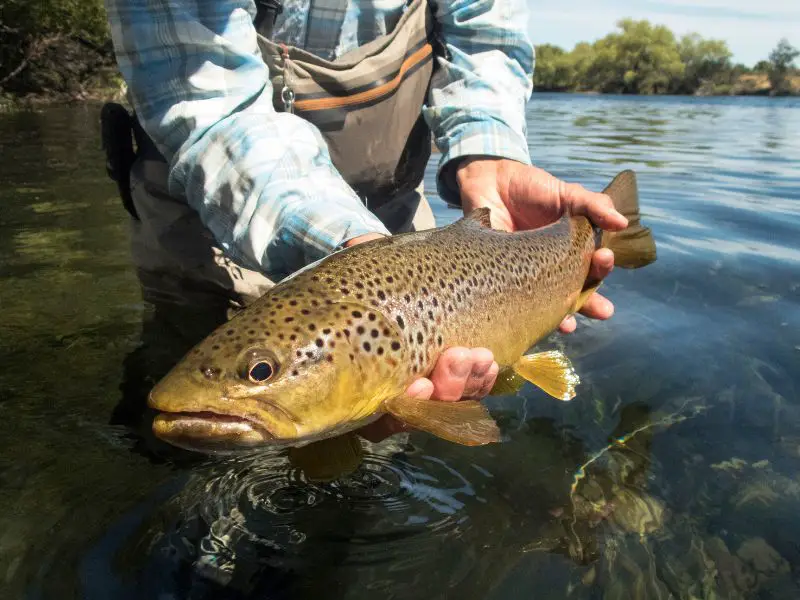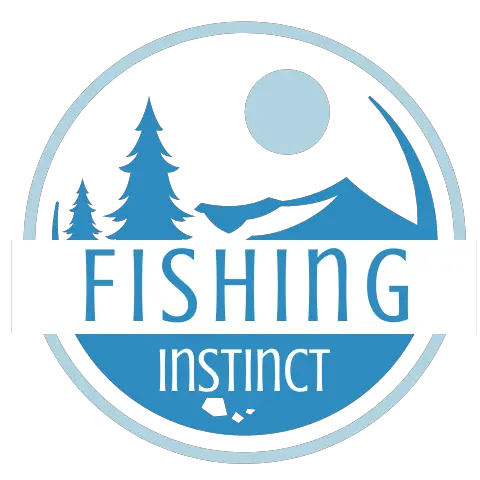Trout are freshwater fish. However, some species such as steelhead and rainbow trout are anadromous, which means that they migrate from freshwater to saltwater and back again. Trout are native to cold-water streams in North America, Europe, and Asia, and are often stocked in lakes and rivers for recreational fishing.
Let’s take a closer look at why trout are freshwater fish and how they migrate to the ocean.

Why Trout is Freshwater (Mostly)
Trout have a number of physical and behavioral adaptations that allow them to thrive in freshwater environments. For example, they have a streamlined body shape that helps them swim efficiently in fast-moving water.
They also have a highly developed lateral line system, which enables them to detect vibrations and changes in water pressure and helps them navigate their river environments. Additionally, trout have a keen sense of smell, which helps them quickly locate food and avoid predators.
Overall, trout are adapted to living in cold, oxygen-rich water, and they require clean, clear water to survive.
How Trout Migrate to the Ocean
The migration of trout to the ocean typically occurs during the juvenile stage of their life cycle. After hatching in freshwater streams and rivers, young trout will typically spend several months or years feeding and growing in these environments before they are ready to migrate to the ocean.
When the time comes for the trout to migrate, they will typically travel downstream to the nearest body of saltwater, such as a bay or an estuary. Once they reach the ocean, they spend several years feeding and growing in these environments before returning to freshwater to spawn.
The migration of trout to the ocean is a complex process that is influenced by a variety of factors, including the specific species, the location, and the environmental conditions.
Some trout species, such as steelhead, will migrate over long distances and may travel hundreds or even thousands of miles from their birthplace to the ocean and back again. Other species, such as rainbow trout, may only migrate short distances.
Which Trout are Freshwater?
In the United States, the most common species of trout include the brook trout, the brown trout, the cutthroat trout, the golden trout, and the rainbow trout. These species can be found in many states across the country, although they may vary depending on the specific habitat.
Here’s a list of the freshwater trout.
- Brook trout (Salvelinus fontinalis): This species is native to North America and is also known as brook char or speckled trout. It is found in cold-water streams and rivers, especially in the eastern and central United States.
- Brown trout (Salmo trutta): This species is native to Europe, but it has been introduced to many other parts of the world, including North America. It is found in cold-water streams and rivers and is known for its ability to adapt to a wide range of environments.
- Cutthroat trout (Oncorhynchus clarkii): This species is native to the western United States and is named for the distinctive red or orange slash marks on its underside. It is found in cold-water streams and rivers, especially in the Rocky Mountains.
- Golden trout (Oncorhynchus aguabonita): This species is native to California and is known for its distinctive golden coloration. It is found in high-elevation streams and lakes in the Sierra Nevada mountain range.
- Rainbow trout (Oncorhynchus mykiss): This species is native to the western United States, but it has been introduced to many other parts of the world. It is found in cold-water streams and rivers and is known for its bright, colorful appearance.
There are many other species of trout that are found exclusively in freshwater habitats, including the Arctic char, the Arctic grayling, the Dolly Varden trout, and the splake.
Which Trout are Saltwater?
Steelhead trout (Oncorhynchus mykiss) are a type of rainbow trout that are native to the Pacific Coast of North America. They are found in cold-water streams and rivers and migrate to the ocean as juveniles, where they spend several years before returning to freshwater to spawn.
Steelhead are popular with anglers and are highly prized for their size and fighting ability.
These species are adapted to living in both freshwater and saltwater environments, and they are able to tolerate the higher levels of salt present in the ocean.
However, most species of trout are found exclusively in freshwater habitats and do not migrate to the ocean. These include species such as brook trout, brown trout, cutthroat trout, golden trout, and many others.
What Do Trout Eat?
Trout are omnivorous, so they eat a variety of plant and animal matter. Their diet depends on the species, location, and availability of food.
Here are some of the things trout typically eat:
- Insects: Many species of trout feed on insects, including mayflies, caddisflies, stoneflies, and others.
- Crustaceans: Some species of trout, such as brook trout and rainbow trout, feed on crustaceans, such as crayfish and shrimp.
- Mollusks: Some species of trout, such as brown trout and cutthroat trout, feed on mollusks, such as snails and clams.
- Fish: Some species of trout, such as brown trout and lake trout, feed on other fish, including smaller trout and minnows.
- Algae: Some species of trout, such as golden trout, feed on algae and other aquatic plants.
- Terrestrial insects: Some species of trout, such as rainbow trout, will feed on terrestrial insects that fall into the water, such as grasshoppers and ants.
- Vertebrates: Some species of trout, such as lake trout and brook trout, will feed on small mammals and birds that fall into the water or are washed downstream.
Trout are opportunistic feeders, and they will generally eat whatever food is most readily available to them.
Is Eating Trout Sustainable?
Trout are a popular food fish, and they can be sustainably harvested from both wild and farmed populations.
Wild trout populations can be sustainably managed through the use of catch limits, size limits, and other regulations that aim to ensure that the population is not overfished. In addition, efforts are often made to restore and protect trout habitats, such as streams and rivers, to ensure that the population has sufficient resources to thrive.
Farmed trout are also a sustainable source of food. Trout are easy to farm and can be raised in a variety of systems, including land-based and floating net pens. Farmed trout can be an efficient source of protein, as they have a relatively fast growth rate and are fed a diet that includes a high proportion of plant-based feed.
However, it is important to ensure that farmed trout are raised in a way that minimizes negative impacts on the environment, such as water pollution and the spread of diseases or parasites to wild populations.
In general, both wild-caught and farmed trout can be sustainably harvested and consumed as part of a well-balanced diet. Consider the origin and methods of production when purchasing and consuming any type of seafood, including trout.
